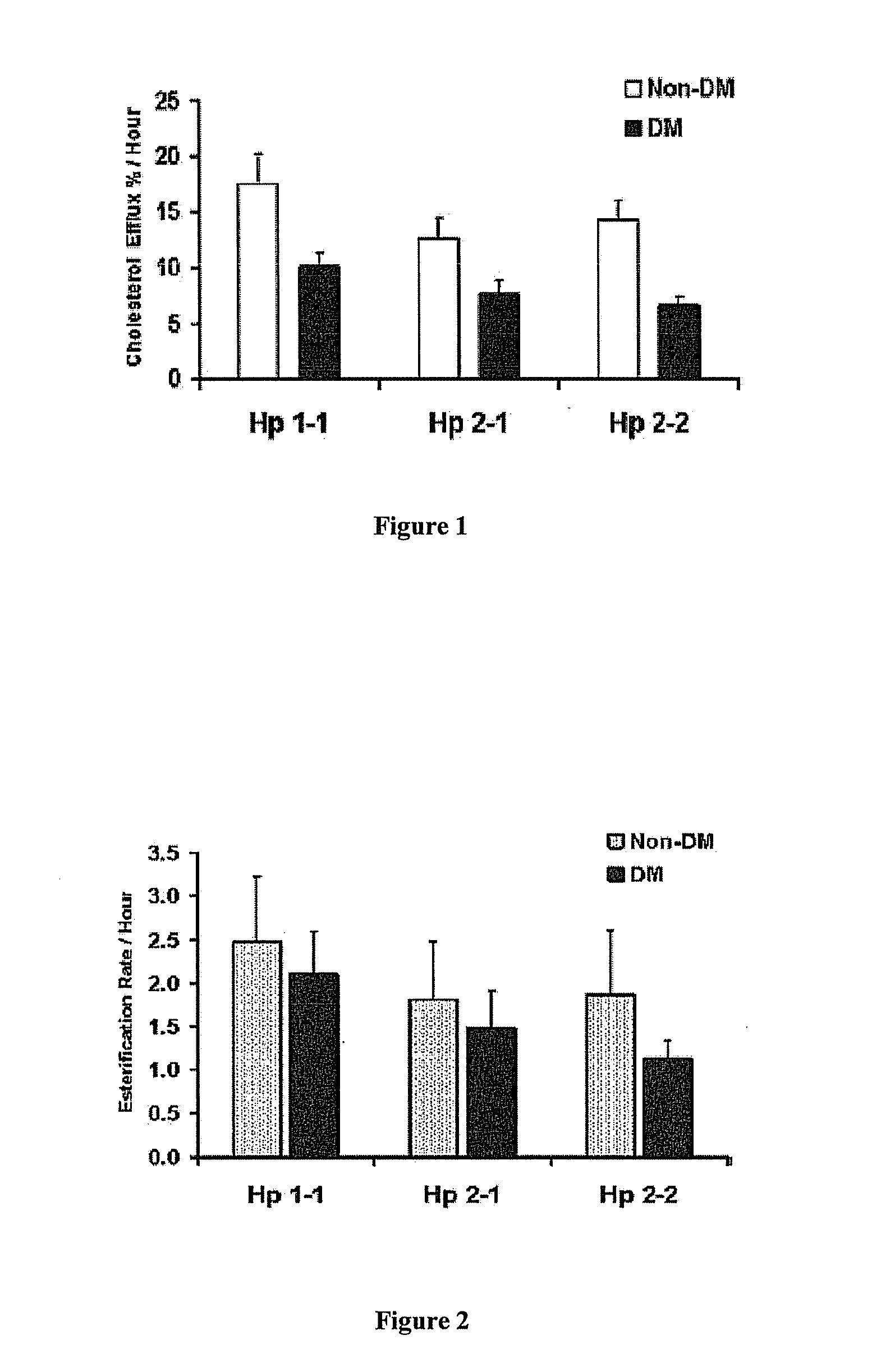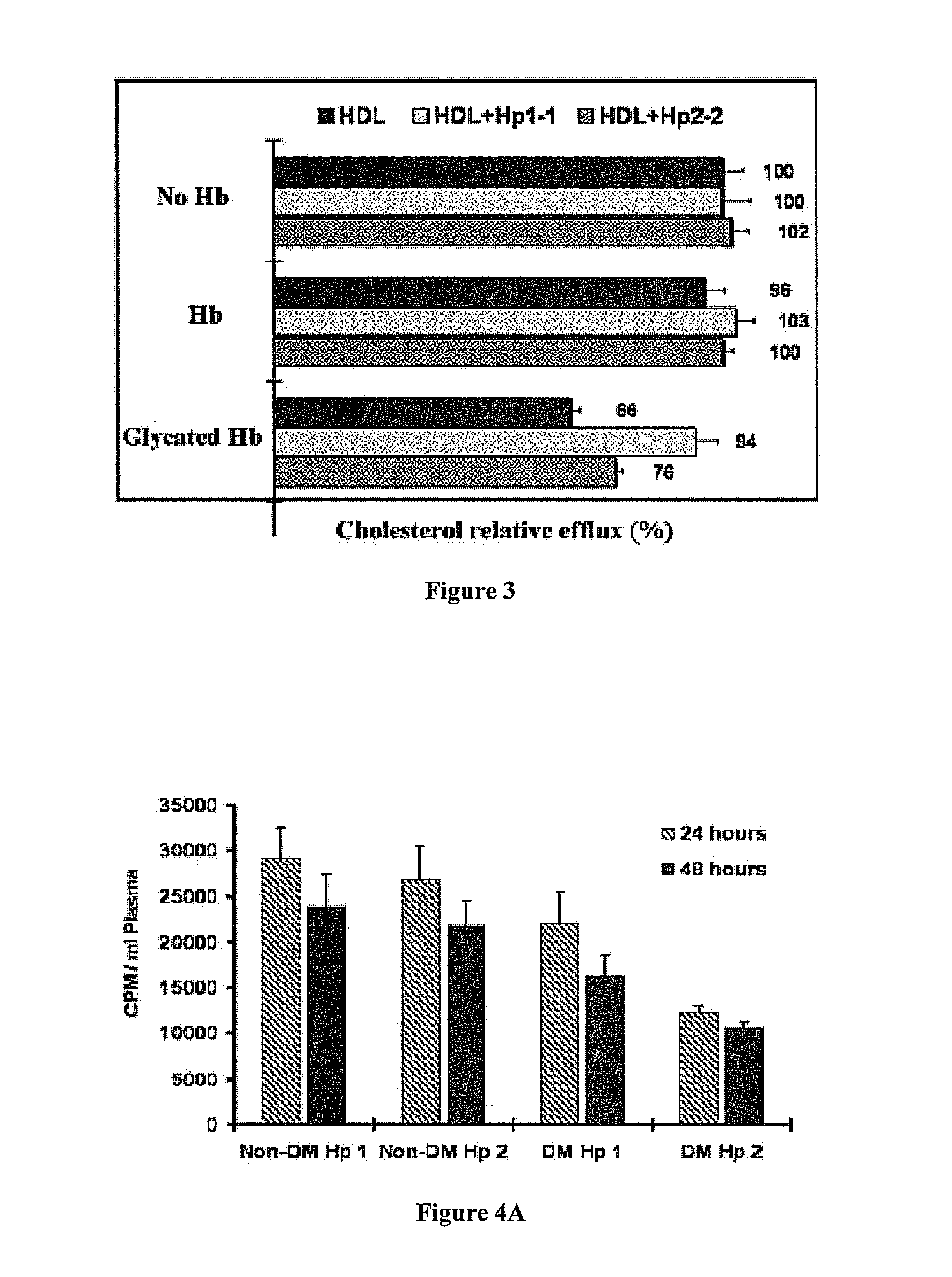Use of haptoglobin genotyping in diagnosis and treatment of defective reverse cholesterol transport (RCT)
a reverse cholesterol transport and haptoglobin technology, applied in the direction of biocide, peptide/protein ingredients, instruments, etc., can solve the problems of oxidative tissue damage, mice lacking the hp gene demonstrate a dramatic increase in oxidative stress, heart attacks and strokes, etc., to reduce oxidative stress, reduce oxidative stress, and reduce oxidative stress
- Summary
- Abstract
- Description
- Claims
- Application Information
AI Technical Summary
Benefits of technology
Problems solved by technology
Method used
Image
Examples
example 1
Impaired Cholesterol Efflux from Macrophages Elicited by Serum from Hp2 DM Individuals
[0243]We sought to determine whether there were differences in cholesterol efflux from macrophages incubated with serum from 90 DM and 72 non-DM individuals segregated by Hp genotype. Patients included in this analysis were randomly selected from a larger cohort of individuals from whom stored sera were available to ensure an equal distribution of the three Hp genotypes. Consistent with previous reports, we found that the serum Hp concentration was Hp-type dependent, with significantly mean higher values in Hp1-1 and lower mean values in Hp2-2. The serum Hp concentration segregated by Hp genotype in the DM cohort was 1.78±0.34 mg / mL for Hp1-1 individuals, 1.92±0.11 mg / mL for Hp2-1 individuals, and 1.25±0.08 mg / mL for Hp2-2 individuals. In the non-DM cohort, the Hp concentration was 1.75±0.12 mg / mL for Hp1-1 individuals, 1.47±0.09 mg / mL for Hp2-1 individuals, and 1.16±0.12 mg / mL for Hp2-2 individual...
example 2
LCAT Cholesterol Esterification Rate is Markedly Reduced in Diabetic Patients with the Hp2 Allele
[0245]We sought to determine whether there were any differences in the LCAT cholesterol esterification rate in the diabetic state and whether LCAT cholesterol esterification rate was associated with the Hp type. We measured LCAT cholesterol esterification rate in the serum of 84 DM and 62 non-DM individuals with Hp1-1, Hp2-1, and Hp2-2 (the same patients in whom cholesterol efflux was measured: Example 1 and FIG. 1). We found a pattern similar to what was observed for cholesterol efflux. In non-DM individuals there were no differences in LCAT cholesterol esterification rate according to the Hp type (FIG. 2). In DM individuals, we found that the highest LCAT cholesterol esterification rate was observed in Hp1-1 individuals, the lowest in Hp2-2 individuals, and an intermediate level in Hp2-1 individuals. In the Hp1-1 group, there was no significant difference in LCAT cholesterol esterifica...
example 3
Decreased Cholesterol Efflux from Macrophages Incubated with Glycated Hb and Hp2-2
[0246]We sought to examine whether the reduction in the cholesterol efflux from cells elicited by serum from DM individuals with the Hp2 allele could be recapitulated using purified Hp and Hb. We found that the addition of Hp1-1, Hp2-2, or native Hb did not cause any reduction in the HDL-mediated efflux of 3H-cholesterol. However, the addition of glycated Hb resulted in a significant 35% reduction in HDL-mediated cholesterol efflux (P<0.001). Hp1-1 was able to block the glycated Hb impairment in HDL-mediated cholesterol efflux by more than 80±6% as compared with only 30±4% with Hp2-2 (P<0.001) (FIG. 3).
[0247]These foregoing observations can be explained by differences in the oxidation of proteins or lipids involved in cholesterol efflux. To demonstrate that glycosylated Hb can oxidatively modify molecules involved in the efflux process within the time frame of this experiment (3 hours), we assessed the...
PUM
| Property | Measurement | Unit |
|---|---|---|
| volume | aaaaa | aaaaa |
| temperature | aaaaa | aaaaa |
| pH | aaaaa | aaaaa |
Abstract
Description
Claims
Application Information
 Login to View More
Login to View More - R&D
- Intellectual Property
- Life Sciences
- Materials
- Tech Scout
- Unparalleled Data Quality
- Higher Quality Content
- 60% Fewer Hallucinations
Browse by: Latest US Patents, China's latest patents, Technical Efficacy Thesaurus, Application Domain, Technology Topic, Popular Technical Reports.
© 2025 PatSnap. All rights reserved.Legal|Privacy policy|Modern Slavery Act Transparency Statement|Sitemap|About US| Contact US: help@patsnap.com



